
Same Day Service
Since 1992
Call The Gentleman Pros Now!
403-879-1760


There are a variety of types of air conditioners used in homes. This article focuses on one type of AC unit, a split air conditioner.
To truly understand the difference between the types of residential air conditioners, I will explain each type, and where they are best used.
Split Air Conditioners have 2 major components split between them, an indoor component and an outdoor component. The indoor unit contains the cooling coil (or A coil). The outdoor unit houses the compressor and condenser.
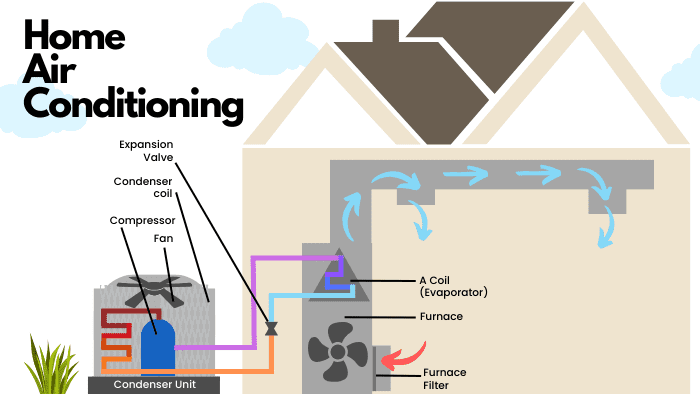
A ductless mini split air conditioner operates on the same principles as a split AC system, except that they do not require venting for distribution. Just like a typical AC split system, there is an outdoor unit that houses the compressor and the condenser.
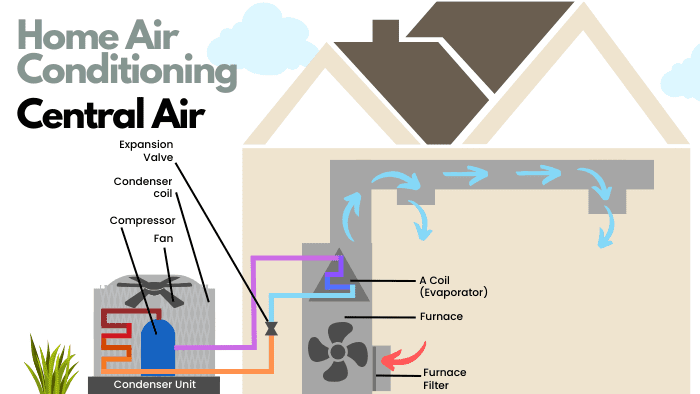
Individual indoor AC units are placed in specific areas, providing cooling for the room. The indoor units can be controlled individually, allowing different temperatures in each zone. A mini-split is not as aesthetically appealing and isn’t ideal for a large home.
Central air conditioning systems are synonymous with ductwork that allows cool air to flow through your entire home. Central air conditioning operates on a split AC system, but not a ductless mini-split system.
In Calgary, Edmonton and Red Deer most of us use a furnace for central heating. (One exception is a boiler system.) Consequently, when AC is installed in a home in Calgary, Edmonton or Red Deer, the existing ductwork will be used to convey the cool air through the home.
A mini-split AC system, on the other hand, doesn’t require ductwork and can be controlled locally, where the indoor units are placed.
An affordable option, window AC units can cool a room or small space. Window AC units are self-contained, meaning, all the parts work together in one unit. Window AC have limitations, but they are easily installed and a relatively inexpensive option.

Think of a hotel room when you are picturing a packaged terminal air conditioner. They are self-contained units that are installed through a window and often provide both heating and cooling functions.
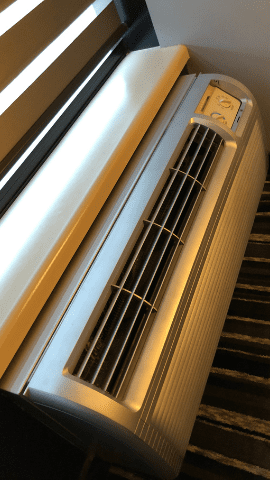
Portable air conditioners are stand-alone units that can be moved from one room to another. They usually vent through the window with a temporary vent kit that can be moved from one window to another. Portable air conditioners are usually very affordable, and have the ability to cool a roo.

Good question!
Just like horsepower a measuring unit transitioning from horse to steam power, a ton of refrigeration (or refrigeration ton) was a unit of measure predating mechanical refrigeration.
In the 1800s ice harvesting became a thriving industry. Ice was transported and used to cool icehouses, and iceboxes, providing refrigeration.
Refrigeration ton is the amount of heat transferred to heat or melt one ton of ice in 24 hours.
Obviously, the historical reference to ice is relevant to modern air conditioning systems, but the term “ton” stuck around, and is still a measurement of cooling capacity.
Today, when choosing cooling capacity, it is important to understand the various factors involved to ensure you have the right cooling capacity. Room size, climate conditions, and insulation are important factors that are considered before your ac installation. Each factor plays a role in determining the required cooling tonnage you need from your air conditioner.
BTU stands for British Thermal Unit and is a unit of measurement commonly used in the heating, ventilation and air conditioning industry.
One ton of refrigeration, or cooling capacity, is equivalent to 12,000 BTUs per hour.
In the heating and cooling industry, BTUs are used to measure heating and cooling capacities. The cooling capacity of an air conditioner is often measured in terms of BTU/h.
It is extremely important to ensure that the BTU rating meets the requirements of your home!
Be sure to choose the right AC unit, with the correct cooling capacity for the size of your home.
Many factors influence the amount of cooling capacity needed to cool your home. The size of your home is the greatest factor, but other variables play an influence too.
Insulation, climate, and ceiling height are influencing factors that impact the cooling of your home. Windows, including what direction of your home the face, the number of windows and window size also play a role in the cooling capacity needed from your AC unit.
We strongly recommend having an HVAC specialist do a detailed load calculation to determine the needed AC cooling capacity.
A manual J calculation was developed by the (Air Conditioning Contractors of America) and is a widely accepted industry standard, even here in Canada. It is used to determine the heating and cooling loads of residential buildings.
The manual J takes into account various factors, that influence cooling capacity, such as the square footage of the home, insulation levels, climate conditions, window orientation, ceiling height and occupancy.
The rule of thumb, in estimating the cooling capacity required for an area, is 1 ton of cooling capacity for every 400-600 square feet. Don’t base your AC purchase on a rough estimate. We advise talking with an HVAC technician who can provide a detailed load calculation.
A detailed load calculation takes into account all the factors affecting cooling capacity needs. Carefully determining the cooling load needed can prevent having hot spots or cool spots in your home.
Simple rule-of-thumb methods can be misleading and result in the wrong AC model being installed. We know first hand, a detailed load calculation is often overlooked. Frequently homeowners don’t install the right air conditioner or furnace, with the proper cooling or heating capacity.
Airflow is another important consideration in maintaining a consistent temperature in your home. If your A/C unit can properly push cold air through the house, it can mitigate having hot spots or cool spots.
Adequate supply and return vents that are strategically placed to help circulate the air. While return vents draw air back into the AC unit, supply vents deliver cooled air. The vents and ductwork must be well-designed to ensure that air is delivered evenly through your home. In addition, ceiling fans can promote air circulation, and regulate temperature imbalances.
Airflow obstructions can inhibit good airflow circulation, and create temperature imbalances. For your air conditioner to provide the best airflow, be sure to move anything blocking the vents. Adjust rugs, curtains or furniture that disrupt the airflow.
After ensuring nothing is inhibiting the airflow through the vents, be sure to have your a/c unit serviced. Regular maintenance and cleaning of your air conditioner can help maintain airflow. The coils and fins inside the AC compressor can be damaged very easily. Be sure to consult a professional on the best way to clean and maintain your air conditioner.
Zoning systems can help create optimal comfort, by dividing the home into various zones. Independent controls in each zone allow each area to maintain its temperature. This can help prevent unwanted hot spots or cool spots.
A SEER rating is often used as a measure of efficiency for air conditioning systems. SEER stands for Seasonal Energy Efficiency Ratio.
The higher the SEER rating, the more energy-efficient the air conditioner is.
A SEER rating is calculated by the cooling output in BTUs divided by the energy input in watt-hours over the cooling season. The cooling season will vary for a region.
The SEER formula calculation is:
For, example, if your air conditioner had a SEER rating of 14, it would mean that for every 1 watt-hour of energy input, the air conditioner would provide about 14 BTUs of cooling output during the cooling season.
Keep in mind that the SEER rating rates the AC unit at its peak operating efficiency. Just like fuel efficiency in a car, the ratio changes depending on the circumstance the machine is performing under.
In some areas, a certain SEER rating is required by law. In the United States, the minimum required rating is typically 14 SEER. California demands a higher SEER rating, the minimum requirement is 15 SEER.
In Canada, the minimum can vary by province. Most provinces require a minimum 13 SEER rating, but in British Columbia, the minimum SEER requirement is 14 SEER.
Currently, there is no minimum SEER requirement in Alberta, so if you are purchasing an AC unit, consider the SEER only as a guide for efficiency.
Having an energy-efficient AC unit may save you money on your energy bill. Consider the pros and cons of various AC units, including efficiency, cost, and the amount of cooling required in your home.
The amount of cooling required in your home varies for many reasons including:
Choosing an AC unit with the highest SEER rating isn’t always worth the cost or the other trade-offs.
Most air conditioning units have a SEER rating between 13 and 22. In the 1980s, AC SEER units was often 8 or less. Over the years AC units have become more efficient. AC systems have values as high as 26.
In Calgary, Edmonton, or Red Deer where air conditioning is only needed a few months of the year the energy savings from an AC unit rated above 20, most likely would never be seen.
Higher SEER-rated AC units can be more costly. In warmer climates where air conditioners are needed almost every day, homeowners will get the maximum value for a high efficiency. In a cooler climate, the operation cost savings is diminished.
The top-end, highest SEER-rated AC units are most often more to service. Replacement parts can be more expensive.
The SEER rating energy guides compare AC performance in climates different than Calgary, Edmonton and Red Deer. SEER is an evolution of performance over a “typical cooling season”. The SEER tests are limiting because they are tested in temperatures that don’t reflect every climate zone.
An ERR (energy efficiency rating) can be more effective in communicating the costs required to operate your AC. A higher EER rating means you are getting more cooling for less energy.
Do you notice the stark difference between EER and SEER ratings in this chart?
Just like a furnace, air conditioners are available in single, dual (two-stage) or variable speed.
What is a single, dual (two-stage) or variable speed air conditioner exactly?
In the simplest terms, single-stage air conditioning has an off and an on. So whether it is required or not, when a single-stage air conditioner is on, it is operating at full capacity.
At times, this can be like using a pressure washer to water your daffodils.
For example, if you set your home to 18 degrees C, just before the temperate climbs above that the A/C compressor will turn on, and cool the air to maintain the desired level.
The biggest advantage of a single-stage air conditioner is the price. A single-stage A/C unit will effectively cool your home, but you will spend a little more on your energy bill.
In Calgary, Edmonton, and Red Deer, where the cooling needs of a home are less than in a warmer climate, this may be your best choice.
The operational cost savings may not outweigh the purchasing cost savings. Compare models and prices to ensure you choose the best model to meet your needs. Consult a cooling expert in your area, to gain a better understanding of your home’s required cooling. Be wary of the SEER rating that gives a narrow perspective of efficiency.
Dual-stage or two-stage air conditioners provide more efficiency. In a two-stage air conditioner, the compressor will operate at 2 stages, the first at 65% and the second stage at around 100% depending on the model.
This allows the dual-stage air conditioner to provide less cooling when less is required, saving energy and cost.
The pros of a dual-stage ac compressor are that it is a compromise between a single-stage and multi-stage ac unit. A dual-stage AC unit will provide more efficiency, and cost somewhere in between a single-stage or multistage AC unit.
Multi-stage air conditioners operate on variable settings or speeds, meeting only the required cooling demand. The output of the air conditioner is matched to what is demanded, making a multi-stage air conditioner more efficient. The AC compressor can provide more precise temperature control based on the number of stages.
The major drawback of a multi-stage air conditioner is the price.
In situations where the cooling needs are extremely high, and the air conditioner is in operation much of the year, variable (multi-stage) air conditioners are worth the expense. In some climates, the operational cost savings over the years will make up for the initial cost. It is important to consult with a heating and cooling specialist to understand your cooling needs. Once the cooling load has been factored in, consider the various AC models.
Modulating or variable-speed AC units have the most precise and efficient cooling. A modulation AC unit continuously adjusts the compressor and fan speeds to match the exact cooling demands.
Modulating air conditioners are typically the most expensive. They are typically more energy efficient than their cousins, the multi-stage AC unit. But as the Cadillac of air conditioners, the cost may not be worth the efficiency.
In a split air conditioning unit, the outdoor unit or condenser can be either a top discharge or a side discharge. In the picture below, you can see the difference between the two.
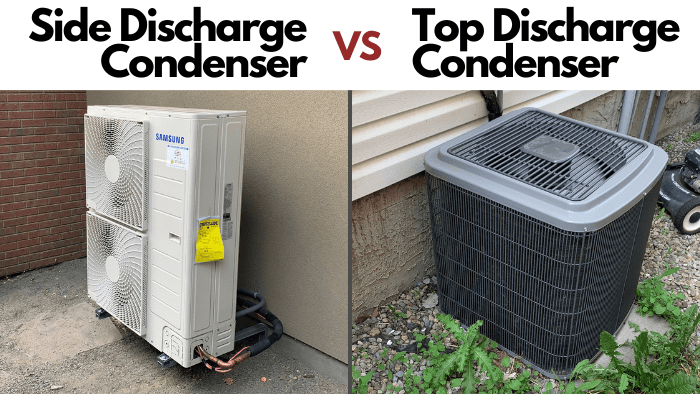
Yes, some air conditioners are louder than others!
If your current AC unit has become louder or is making a new sound, that might be an indication of a problem. In that situation, please schedule a service call to ensure that there isn’t a mechanical problem.
Rather than diagnosing sounds in your air conditioner, I want to explain why some units are louder than others, and what to look for and expect from an air conditioner system.
I want to make it clear that the type of air conditioner I am writing about is a split central air conditioner. This means the AC unit is split into two major parts, the condensing unit and the cooling coil, also known as the A coil or the evaporator.

The sound that is measured on a split AC unit is the condenser unit. Compressed air produces noise as it travels. Market demands have influenced better AC technology, including improvements in noise levels.
AC noise is measured in decibels (dB) and amplitude (A). This means the frequency of the sound wave is measured in decibels and then factored by the force or amplitude of the sound wave.
Noise levels measured by the decibel scale are quietist at the lower numbers, and noisy at the top.
dBA is adjusted to measure the varying sensitivity of hearing. The human ear doesn’t perceive all frequencies of sound. In a dBA rating, low and high frequencies, that are less perceived by the human ear are given less weight than a decibel scale.
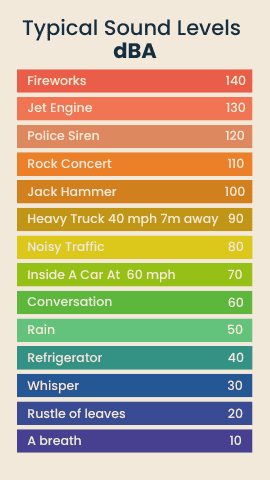
Air conditioners are typically rated for noise level (dBA) at 3.3 feet away from the condenser unit, but often are measured again at 6.6 feet away and 9.8 feet away.
There are some other factors to consider when evaluating noise.
A single-stage AC unit will operate at 100% capacity every time it is on. Consequently, it will produce noise at full blast.
Multi-stage AC units are more energy efficient than a single stage, but often quieter when operating at lower stages.
A dual-stage AC unit will operate at 2 levels about 65% and 100%. Consequently, at 65% the AC unit will not be as loud. Multi-stage and variable or modulating AC units will operate at different, intensities. At lower stages or speeds the AC unit, could be noticeably quieter.
Depending where the condenser is located outside your home might influence the threshold of noise you can tolerate. Planning your yard carefully may help manage the noise from the condenser. If possible, plan to have your condenser unit placed away from your deck or a gathering area.
Another factor that can affect the noise level of your AC condenser unit is the compressor. There are different types of compressors and ranges of efficiency.
Rotary compressors can speed up or slow down to circulate the demanded refrigerant. Rotary compressors are significantly quieter than typical compressors and are among the most efficient compressors.
Did you know you should have your AC unit serviced every year?
Proper maintenance on your AC unit will ensure that your AC will operate at peak performance.
Your AC condensing unit will not perform properly if the airflow is not able to travel through the condensing unit. Often dirt, dust, leaves and debris get into the outdoor unit and disrupt the airflow efficiency.
Be very careful cleaning your outside condensing unit, because the coils and fins bend and damage very easily. Have a professional inspect and clean your AC unit every year.
Yearly maintenance and inspection will detect problems early. A technician can identify signs of wear, leaks or faulty components. Some manufacturers require yearly maintenance to maintain warranty coverage.
